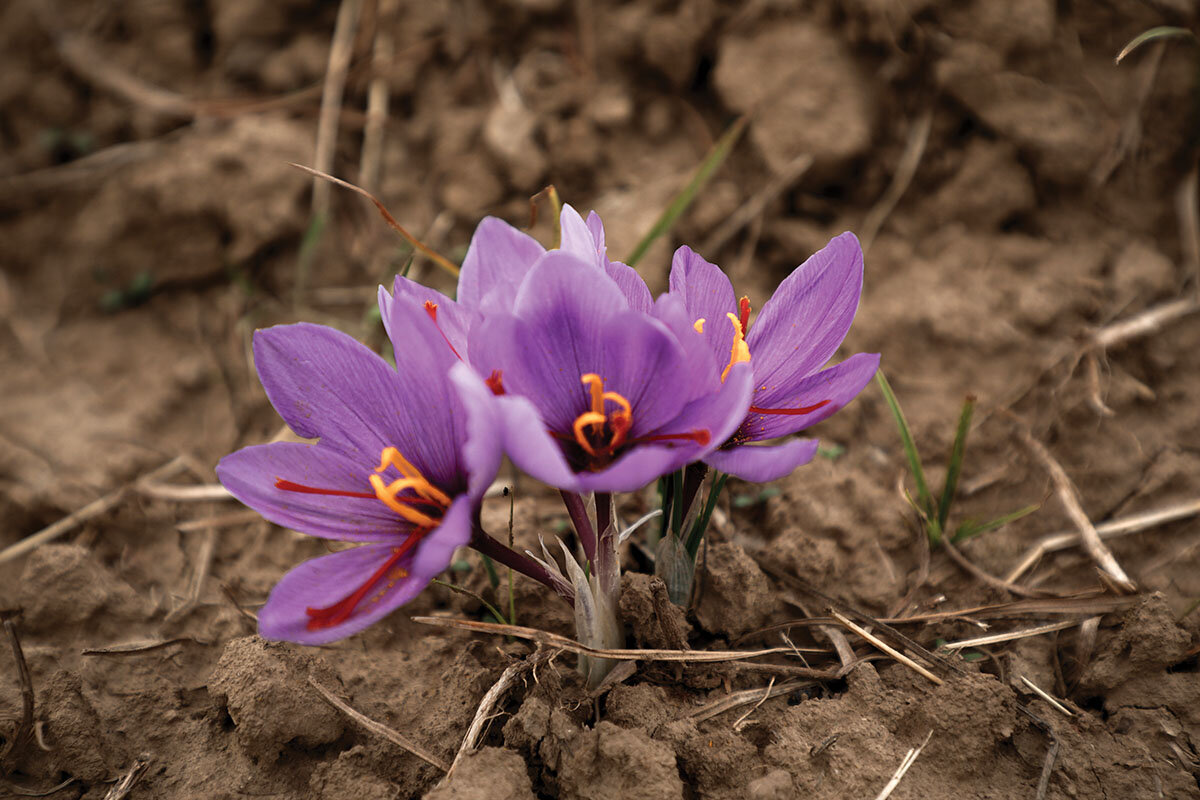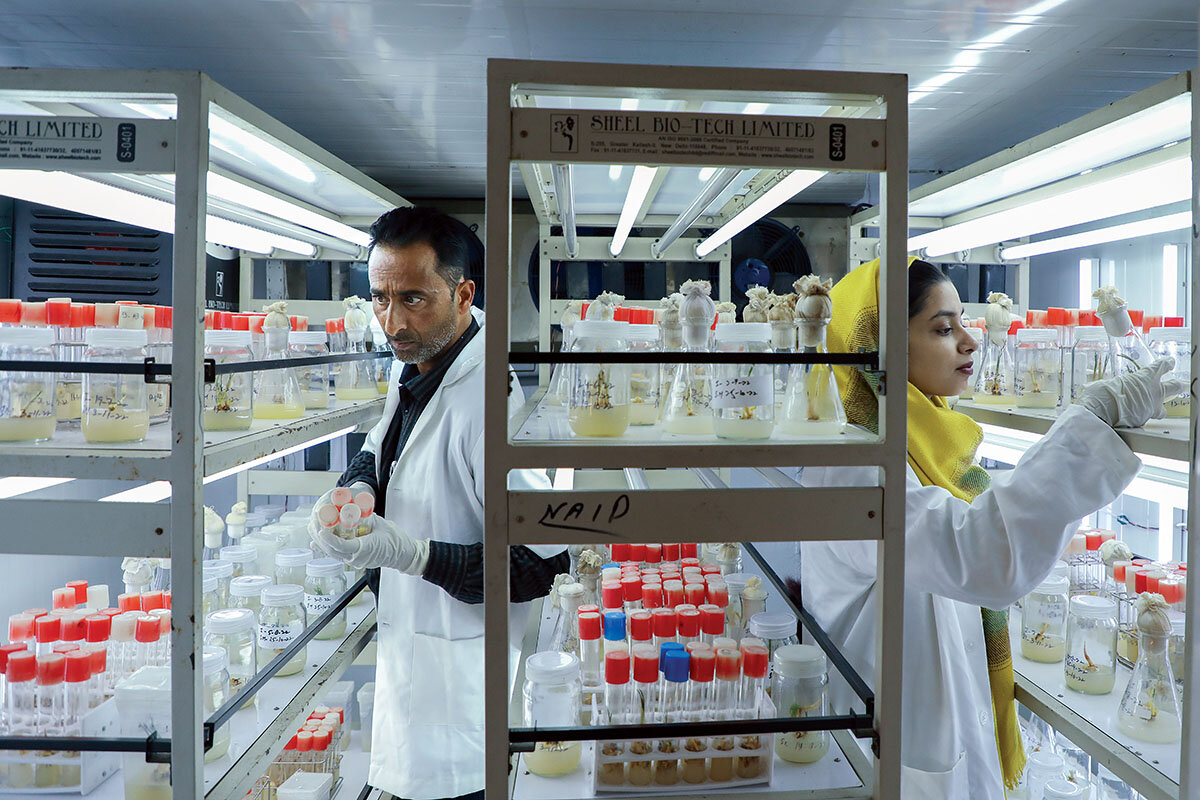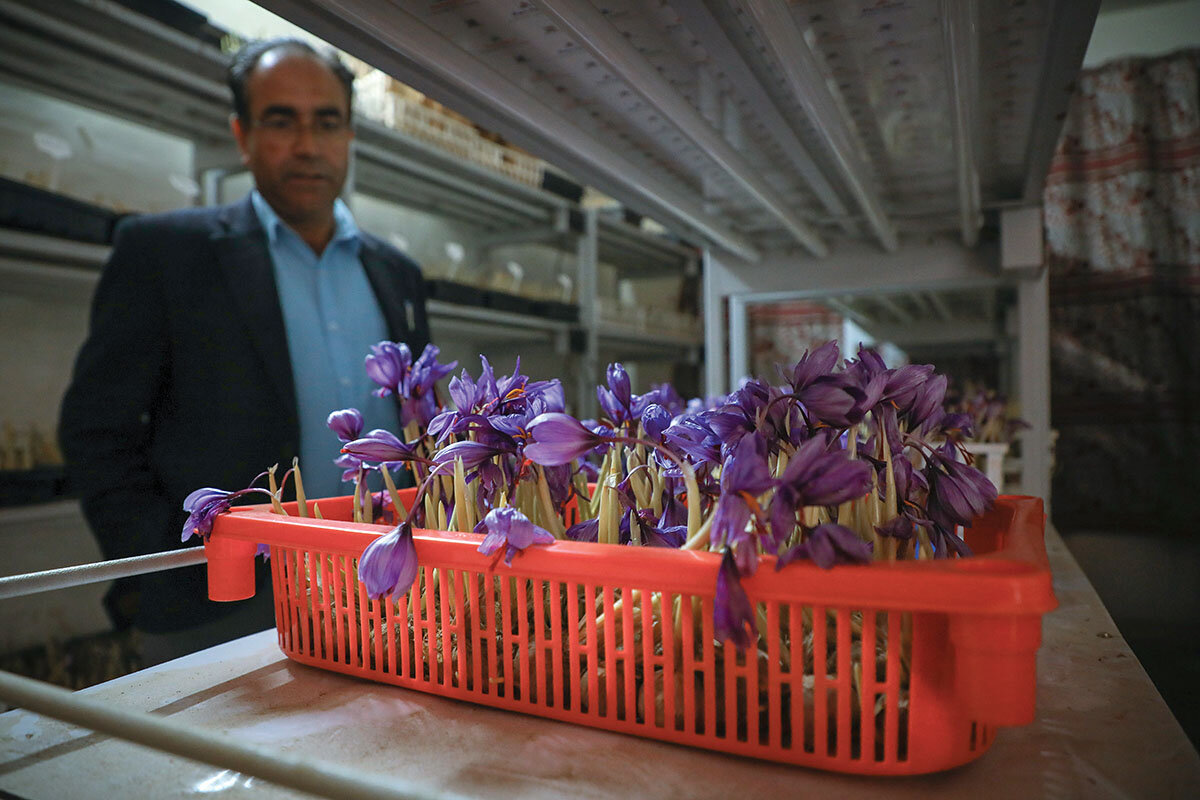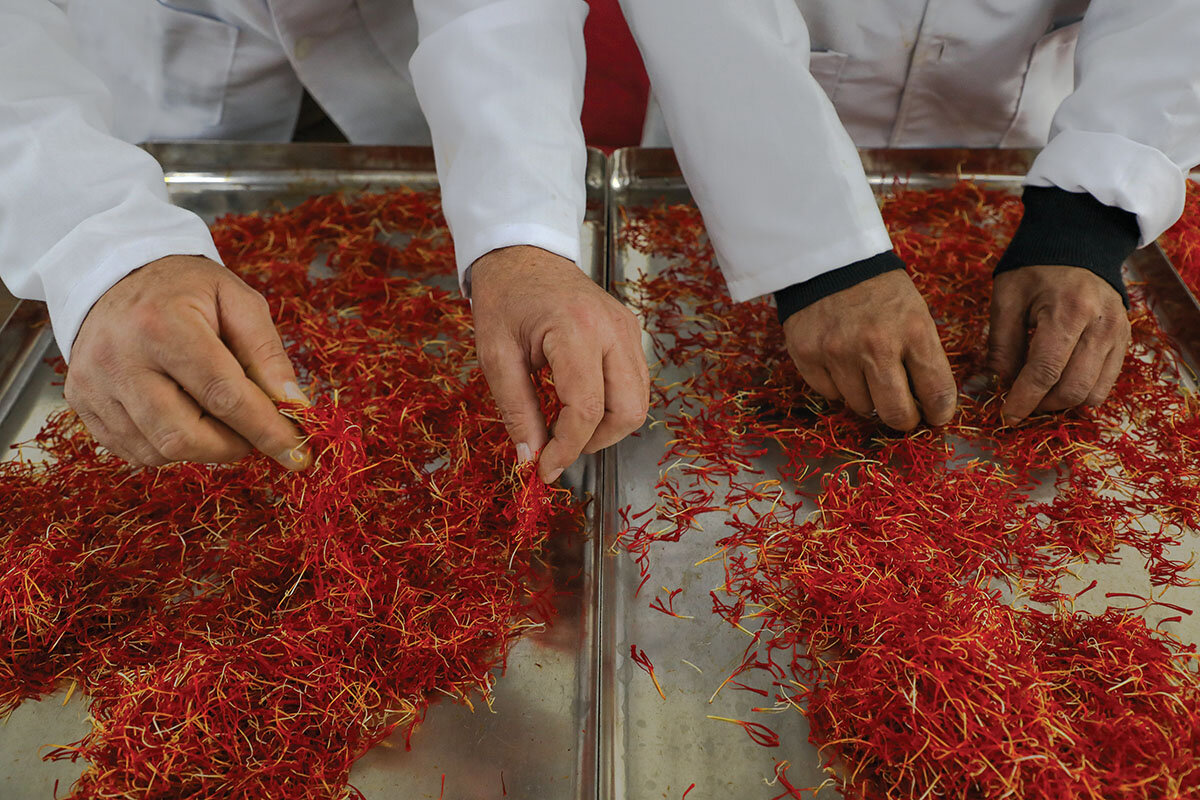Crocus blooms in the living room? Kashmir's saffron farmers get creative.
Loading...
| Pampore, India
Abdul Majeed Wani uses a flashlight to carefully inspect his blooming saffron crocus plants in red plastic baskets placed on iron racks. He’s deliberately deprived this small room of natural light, covering the windows to “maintain the quality” of the crop.
Mr. Wani is among the first farmers in Kashmir to embrace this relatively new technique of growing saffron indoors, stacked in vertical columns. “It is the third year I am growing saffron inside my house, and the results are very promising,” he says with excitement. “We have got better produce both in quality and quantity.”
Mr. Wani comes from a traditional saffron-growing family from Shaar-i-Shalli, a hamlet located on the foothills of Zabarwan mountains. Most of the people in his village and the surrounding areas have been growing the prized spice for centuries. Saffron is grown in a few places around the world, requiring unique kinds of soil and specific climatic conditions. Kashmir is the second-largest producer after Iran, and saffron cultivation is seen as a symbol of Kashmiri culture.
Why We Wrote This
A story focused onFarmers say efforts to bolster Kashmir’s struggling saffron industry are starting to pay off, sparking hope across the region.
Although the demand for Kashmiri saffron – which can cost $10,000 per kilogram (2.2 pounds) – is growing, the region has witnessed a steady decline in its production. Farmers and industry experts blame the fast-growing construction in and around the saffron fields, as well as climate change and regional conflict. But government support and breakthroughs in indoor cultivation are offering farmers hope.
“The new technique has raised huge hopes in us,” says Javaid Ahmed, another saffron farmer from Pampore who’s embraced indoor farming. “No matter how erratic rain or how early we receive snowfall, there is now more probability for our saffron to bloom in better ways.”
Agricultural intervention
In 1996, more than 14,000 acres of land were used to grow saffron in Kashmir, according to Department of Agriculture data. Over the next couple decades, that number dwindled to 6,000, and production decreased by nearly 90% from 16 metric tons to 2 metric tons, much of which is attributed to climate change.
“In the past 20 years, we have been witnessing untimely rainfalls and extreme weather events, like sudden rise or fall in temperatures,” says Mr. Wani. In 2014, devastating floods cost Kashmir’s saffron industry about $127 million.
Climate change isn’t the only issue disrupting saffron farming. The Himalayan region is marred by conflict, with India and Pakistan both controlling portions of Kashmir while claiming the majority-Muslim territory in its entirety. In the Indian-administered areas, clashes between separatist rebels and Indian security forces have cost thousands of lives and brought huge distress to the people, who are largely dependent on farming.
Still, there is cause for hope. Since the government launched its “Mission on Saffron’’ in 2010, traditional farmers have gained access to new resources, including the India International Kashmir Saffron Trading Centre (IIKSTC) in Pampore. IIKSTC aims to streamline saffron production, with facilities to separate and dry stigmas (the part of the crocus from which the spice is derived) for auction, as well as provide better marketing avenues and secure higher prices for farmers.
The center fixes auction rates based on stigma quality, and certifies the authenticity of Kashmiri saffron sold in India and abroad. This sort of quality regulation is critical, say farmers, to combat the proliferation of cheaper “Kashmiri saffron” knockoffs and preserve the spice’s reputation as the best saffron in the world.
In addition to these post-harvest supports, the government is working to safeguard remaining farmland from development and provide farmers with better irrigation facilities, such as tube wells and sprinklers. Meanwhile, scientists in the region have stepped in to reduce their reliance on the land altogether.
How to grow a saffron plant – indoors
Traditional farmers plant their saffron corms, or bulbs, in the fall. The saffron crocuses should bloom the following November, at which point farmers can pluck its flower and harvest the bright red stigma. This cycle repeats for about 3 to 5 years before the original corm decays, leaving behind new bulbs to be planted.
Yet erratic weather can affect that year’s bloom, leading to massive losses if a farmers’ crop fails. Climate changes also result in fewer new corms, explains Mr. Wani, leading to a gradual decline in production.
Hoping to safeguard his family’s farm, Mr. Wani signed up for training at the Advance Research Station for Saffron & Seed Spices, a government initiative affiliated with Sher-e-Kashmir University of Agricultural Sciences and Technology (SKUAST) in Srinagar. There, he learned how to protect his saffron plants during their most vulnerable period.
“Under this new method, we remove the saffron corms from soil a few weeks before the harvest time and place them in these trays inside a room, which has no direct sunlight,” says Mr. Wani.
The sheltered flowers bloom as usual, and after the saffron is harvested, he puts the corms back in the soil.
“The corms need a chilling period of more than 1,000 hours, and the temperature should be below zero degrees [Celsius],” says Bashir Ahmad Elahi, a scientist at SKUAST and head of the research team studying local saffron trends and solutions.
Despite promising results, there are some apprehensions among farmers, as the saffron corm recommended for indoor cultivation is quite large, weighing more than 10 grams.
“We don’t get that type of corm usually,” explains Mr. Ahmed, noting that about 80% of the saffron corms available to farmers are too small for indoor use.
Still, he and other farmers see value in pursuing a hybrid of traditional and vertical farming.
“In a small room, one can produce saffron that would be traditionally cultivated over one kanal [about 3 basketball courts] of land,” he adds.
Hope beyond Kashmir’s saffron fields
Kashmir’s 2021 saffron yield reached a two-decade high of 15.04 metric tons, which farmers partly attribute to good weather, but also better irrigation methods as well as indoor cultivation and other government supports. Available reports on 2022 harvests suggest further growth, though the government has yet to release any official data.
The improving prospects for Kashmir’s saffron farmers have kindled hope at a time when the region’s other major economic source – apple farming – is in crisis, due to similar challenges of erratic weather, plummeting prices, and poor connectivity to Indian markets.
While the vertical farming techniques aren’t directly applicable to Kashmir’s numerous orchards, some say the saffron industry’s progress is proof that with government support and a bit of innovation, farmers can survive difficult times.
For their part, the local horticulture department has already been promoting high-density apple varieties from Europe, which yield more produce and have an earlier harvesting period, helping farmers avoid the early snowfalls that can decimate apple crops.
And as for the future of saffron, Dr. Elahi says the successful vertical farming trials offer hope that other people in Kashmir, even those living in urban areas, can cultivate saffron in their homes. As his team starts training a new cohort of traditional saffron farmers, their experiment is attracting interest from beyond the region, too.
“Some entrepreneurs from outside Kashmir were successfully able to grow saffron with this new technique in different parts of India on a smaller scale,” says Dr. Elahi. “This gives us hope that if we take care of temperature, light, and humidity, we can produce saffron beyond Kashmir.”










